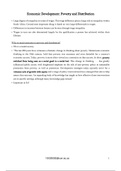Summary
Summary Economic Development: Poverty and Distribution 2018
- Course
- Economics 348 (348)
- Institution
- Stellenbosch University (SUN)
Covers perspectives on economic development, distribution of income and policy affecting poverty and distribution. In-depth class notes along with reader additions where needed. A bundle will be made available for A2, covering all 5 sub-modules, and will be released after classes have finished.
[Show more]



